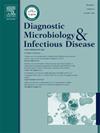Effect of cavity absorption on treatment outcomes of Mycobacterium kansasii pulmonary disease
IF 2.1
4区 医学
Q3 INFECTIOUS DISEASES
Diagnostic microbiology and infectious disease
Pub Date : 2025-01-24
DOI:10.1016/j.diagmicrobio.2025.116712
引用次数: 0
Abstract
Background
The incidence of Mycobacterium kansasii pulmonary disease (MK-PD) was increasing worldwide. However, limited research was conducted on how to improve the cure rate and evaluate treatment efficacy for patients. We aimed to identify key factors that could improve the cure rate in patients with MK-PD.
Methods
In this retrospective cohort study, the medical records of patients with MK-PD, registered with Shanghai Pulmonary Hospital between January 2016 and December 2020, were collected. These included data on demographics, as well as clinical, radiological, microbiological, drug resistance, and drug regimen information, and treatment outcomes. Multivariate logistic regression analysis was conducted to identify risk factors for treatment failure in patients.
Results
This study included 129 patients, of whom 100 (77.5 %) were treated successfully. Logistic regression analysis identified non-absorption of pulmonary cavities as an independent risk factor for treatment successful (odds ratio: 7.9, 95 %confidence interval: 1.7–36.2, p = 0.008). The overall cure rate for patients with absorption of pulmonary cavities (APC) was 93 %; 55 % of patients began resorption within 6 months of the start of treatment (the cure rate was 95 %). The APC rate of patients with MK-PD negatively correlated with the number of comorbidities (p = 0.009); that was, the more comorbidities, the more difficult the cavity absorption and the lower the cure rate.
Conclusions
The absorption of pulmonary cavities was the key to the cure rate for patients with MK-PD. Early changes in cavities helped identify the effect of treatment and guide doctors in optimizing treatment plans to improve patient cure rates.
求助全文
约1分钟内获得全文
求助全文
来源期刊
CiteScore
5.30
自引率
3.40%
发文量
149
审稿时长
56 days
期刊介绍:
Diagnostic Microbiology and Infectious Disease keeps you informed of the latest developments in clinical microbiology and the diagnosis and treatment of infectious diseases. Packed with rigorously peer-reviewed articles and studies in bacteriology, immunology, immunoserology, infectious diseases, mycology, parasitology, and virology, the journal examines new procedures, unusual cases, controversial issues, and important new literature. Diagnostic Microbiology and Infectious Disease distinguished independent editorial board, consisting of experts from many medical specialties, ensures you extensive and authoritative coverage.

 求助内容:
求助内容: 应助结果提醒方式:
应助结果提醒方式:


